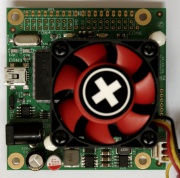THE MINING ECOSYSTEM
0
comments
The mining ecosystem
Hardware
Users have used various types of hardware over time to mine blocks. Hardware specifications and performance statistics are detailed on theMining Hardware Comparison page.
CPU Mining
Early Bitcoin client versions allowed users to use their CPUs to mine. As the network hashrate grew with more power efficient GPU miners the amount of Bitcoin's produced by CPU mining became lower than the cost of power to operate the CPUS. The option still exists in the reference Bitcoin client, but it is disabled by default.
GPU Mining
GPU Mining is drastically faster and more efficient than CPU mining. See the main article: Why a GPU mines faster than a CPU. A variety of popular mining rigs have been documented.
FPGA Mining
FPGA mining is a very efficient and fast way to mine, comparable to GPU mining and drastically outperforming CPU mining. FPGAs typically consume very small amounts of power with relatively high hash ratings, making them more viable and efficient than GPU mining. See Mining Hardware Comparison for FPGA hardware specifications and statistics.
ASIC Mining
An application-specific integrated circuit, or ASIC, is a microchip designed and manufactured for a very specific purpose. ASICs designed for Bitcoin mining were first released in 2013. For the amount of power they consume, they are vastly faster than all previous technologies and already has made GPU mining financially unwise in some countries and setups.
Mining services
Mining contractors provide mining services with performance specified by contract. They may, for example, rent out a specific level of mining capacity for a set price for a specific duration.
Mining shares provide Mining as a Service (MaaS). These break large-scale datacenter mining down to easily manageable pieces that are available in the form of shares of equipment.
Hosted mining services create some systemic risk for the Bitcoin system because they undermine the security assumption that the control of mining power is well distributed. If too much mining becomes consolidated in large hosting providers and an attacker is able to compromise some of these providers they could potentially disrupt the Bitcoin system or rip off people they transact with with reversals.
Pools
As more and more miners competed for the limited supply of blocks, individuals found that they were working for months without finding a block and receiving reward for their mining efforts. This made mining something of a gamble. To address the variance in their income miners started organizing themselves into pools so that they could share rewards more evenly. See Pooled mining and Comparison of mining pools.
History
Bitcoin's public ledger (the 'block chain') was started on January 3rd, 2009 at 18:15 UTC presumably by Satoshi Nakamoto. The first block is known as the genesis block. The first transaction recorded in the first block was a single transaction paying the reward of 50 new bitcoins to its creator.
https://en.bitcoin.it/wiki/Mining#CPU_Mining
TERIMA KASIH ATAS KUNJUNGAN SAUDARA
Judul: THE MINING ECOSYSTEM
Ditulis oleh Advisor
Rating Blog 5 dari 5
Semoga artikel ini bermanfaat bagi saudara. Jika ingin mengutip, baik itu sebagian atau keseluruhan dari isi artikel ini harap menyertakan link dofollow ke https://kiliwir.blogspot.com/2014/03/the-mining-ecosystem.html. Terima kasih sudah singgah membaca artikel ini.Ditulis oleh Advisor
Rating Blog 5 dari 5



0 comments:
Post a Comment